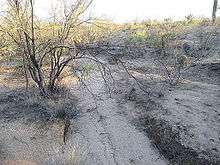Arroyo (creek)


An arroyo (/əˈrɔɪoʊ/; Spanish: [aˈroʝo], "brook"), also called a wash, is a dry creek, stream bed or gulch that temporarily or seasonally fills and flows after sufficient rain.[1] Flash floods are common in arroyos following thunderstorms. In Latin America any small river might be called an arroyo, even if it flows continually all year and is never dry. The Arabic terms rambla or wadi are used in North Africa and Southwest Asia. Arroyos provide a water source to desert animals.
The desert dry wash biome is restricted to the arroyos of the southwestern United States.
Types and processes
Arroyos can be natural fluvial landforms or constructed flood control channels. The term usually applies to a sloped or mountainous terrain in xeric and desert climates. In addition: in many rural communities arroyos are also the principal transportation routes; and in many urban communities arroyos are also parks and recreational locations, often with linear multi-use bicycle, pedestrian, and equestrian trails. Flash flooding can cause the deep arroyos or deposition of sediment on flooded lands. This can lower the groundwater level of the surrounding area, making it unsuitable for agriculture. However a shallow water table lowered in desert arroyo valleys can reduce saline seeping and alkali deposits in the topsoil, making it suitable for irrigated farming.
Natural
In the U.S. state New Mexico, the Doña Ana County Drainage Ordinance defines an arroyo as "a watercourse that conducts an intermittent or ephemeral flow, providing primary drainage for an area of land of 40 acres (160,000 m2) or larger; or a watercourse which would be expected to flow in excess of one hundred cubic feet per second as the result of a 100 year storm event." Research has been conducted in the hydrological modeling relative to arroyos.[2] Natural arroyos are made through the process known as arroyo-cutting. This occurs in arid regions such as New Mexico, where heavy rains can lead to enlargement of rivers cutting into surrounding rock creating ravines which are dry under normal weather conditions.[3] It is argued, however, whether these excessively stormy periods are the sole cause of arroyo-cutting as other factors such as long-term climate changes must also be taken into account.[4] Arroyo cutting which occurred in the 1900s in the southwestern United States caused serious farming issues such as a lowered water table and the destruction of agriculture and grazing lands.
Constructed
In agriculture areas in climates needing irrigation, farmers traditionally relied on small constructed arroyos, acequias, zanjas or aqueduct channels and ditches for the distribution of water.
An example of larger constructed arroyos is in Albuquerque, New Mexico. There are several miles of open-air concrete lined drainage channels that drain an area into the main North Diversion Channel, a tributary of the Rio Grande joining upstream of Albuquerque. After the San Juan Project Water Treatment Plant here, the Rio Grande's flow exceeding that needed for the river's silvery minnow habitat is available for municipal water supply diversion. Signs are posted at the constructed arroyos warning to keep out due to danger of flash flooding.
The Arroyo Seco and Los Angeles River are more famous examples in Southern California of former natural arroyo seasonal watercourses that became constructed open drainage system arroyos.
Notes
- ↑ "Arroyo Definition". MSN Encarta. Archived from the original on 2009-10-31. Retrieved 2009-10-02.
- ↑ "Modeling the Dynamics of Gully and Arroyo Formation Fort Carson and Pinon Canyon Maneuver Site, Colorado" (PDF). Defense Technical Information Center. Retrieved 2009-10-02.
- ↑ King, Cuchlaine; Landforms and Geomorphology: Concepts and History, Wiley, 1976 ISBN 978-0470150542
- ↑ Rice, R. J.; Fundamentals of Geomphology, Longman, 1988 ISBN 978-0582301511
External links
| Wikimedia Commons has media related to Arroyos. |